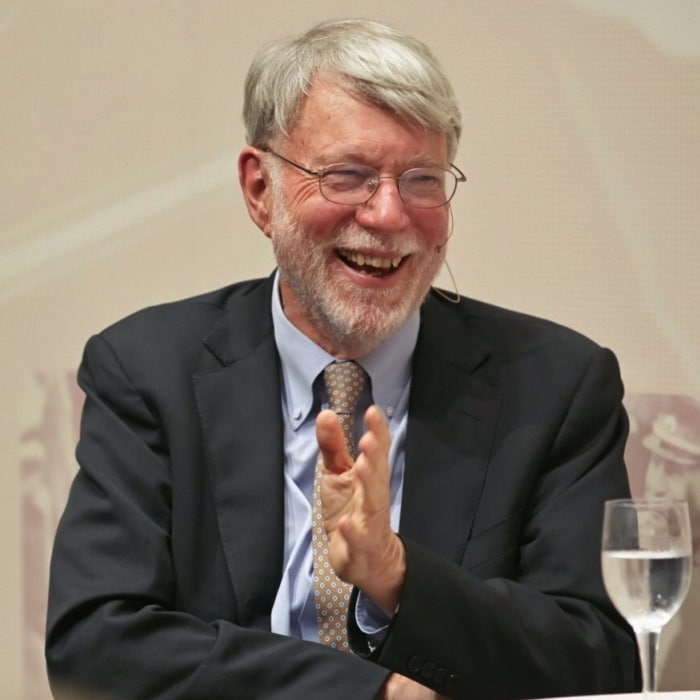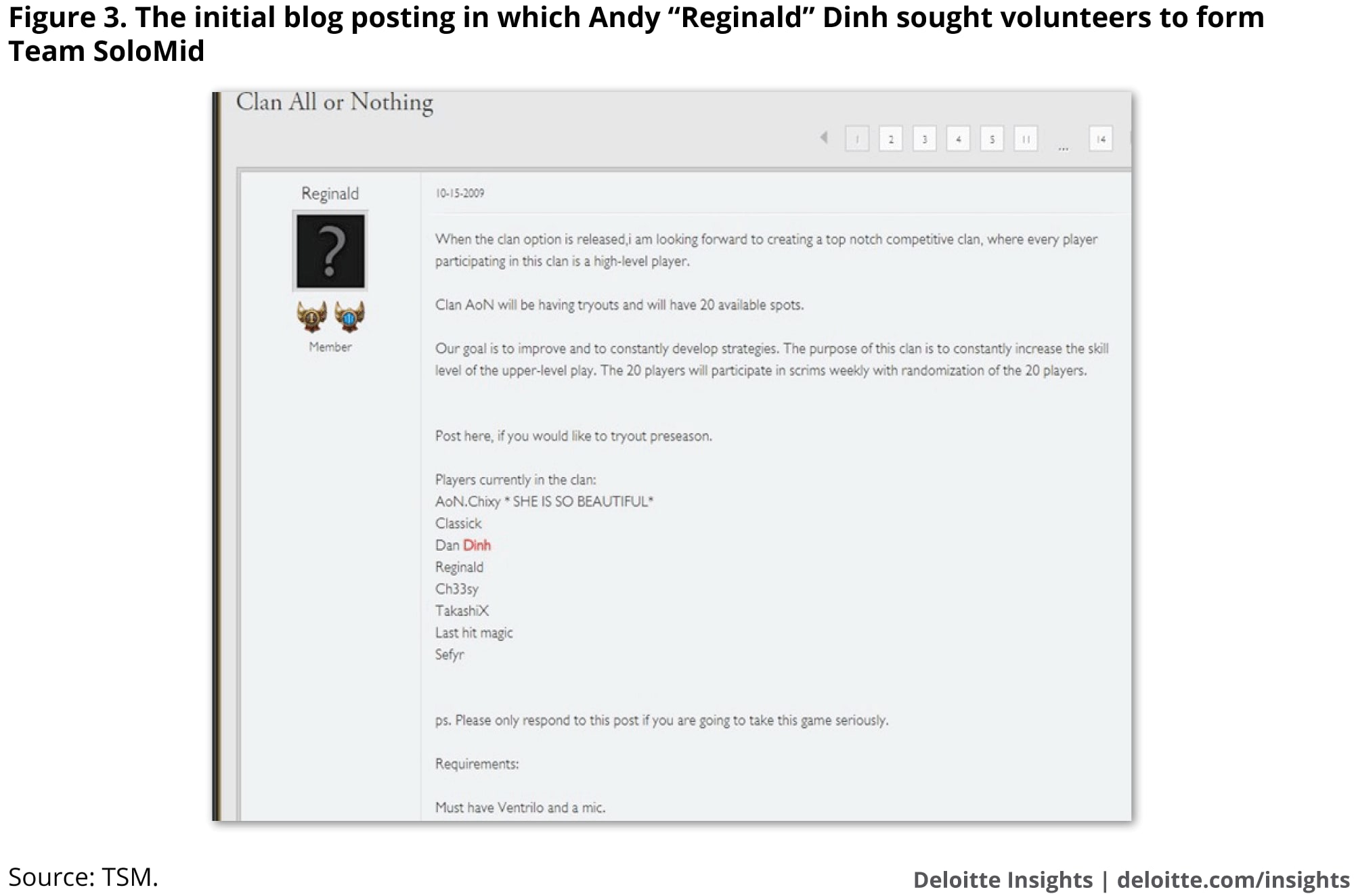League of Legends: Team SoloMid has been saved

League of Legends: Team SoloMid Using metrics to guide rigorous experimentation
07 March 2018
 John Hagel III United States
John Hagel III United States John Seely Brown (JSB) United States
John Seely Brown (JSB) United States Maggie Wooll United States
Maggie Wooll United States Andrew de Maar United States
Andrew de Maar United States
E-sports games are serious business, and winning at League of Legends takes more than just practice. Repeat LoL champion Team SoloMid uses six of the nine practices in focusing on collaboration, interdependence, and continuous improvement.
In the growing $900+ million e-sports market, multiplayer online game League of Legends is a frontrunner, with an estimated 100 million active players each month.1 Team SoloMid is considered one of North America’s top professional teams and has competed at the highest levels globally for six years while improving its win rate in competitive matches.
League of Legends (LoL) is a team-oriented multiplayer online battle arena developed by Los Angeles-based Riot Games. Played in discrete matches, two teams of five players battle each other with the goal of destroying the opposing team’s nexus (home base). Each match is complex and volatile: In-game conditions evolve rapidly, and destroying the nexus requires a collective effort. While players can compete in pickup games on randomized teams assembled by an algorithm, or draw from an in-game friend list to self-organize into match-specific teams, professional teams have emerged, which conduct tryouts, hold practices, and compete together on a sustained basis for team ranking and championships.
Learn More
Explore the practices and case studies
Read an overview of the opportunity
Download the full report or create a custom PDF

Far from a fringe, in 2016 e-sports—typically defined to include any organized multiplayer video game competitions, often involving professional gamers2—generated an estimated $905 million in revenues globally (see figure 1),3 and has an estimated global audience of 1.4 billion fans.4

Riot Games organizes regional tournaments called League Championship Series and holds an annual World Championship with teams from North America, Europe, and Asia. In 2014, 27 million viewers watched the LoL finals online, more than doubling three years later to 60 million viewers for the 2017 final (see figure 2).5 What’s more, a high percentage of viewers play none of the top e-sports games, a sign that these games are poised to become spectator sports in their own right.6
Reflecting this growing popularity, about 30 colleges now offer e-sports scholarships, some up to $25,000 a year,7 with schools such as Columbia, the University of Utah, and the University of California, Irvine fielding varsity e-sports teams.
The workgroup: Team SoloMid
Founded in 2009 and widely considered one of North America’s top e-sports teams, Team SoloMid (TSM) is a group of gamers dedicated to improving their already-high League of Legends performance. While members of Team SoloMid obviously refer to themselves as a team, and we will refer to TSM as such, it fits our criteria for a workgroup and has deliberately focused on improving its performance over time:
- Size: The TSM workgroup includes five active players, two substitute players, two coaches, and a general manager.8
- Sustained involvement: Members of TSM spend the majority of their time together engaged in practice, strategy sessions, or playing the game and experimenting with playing styles.
- Integrated effort: The team can win games only through an interdependent, collaborative effort.
The team competes with approximately 170 other professional teams in at least three tournaments each year9 and since 2011 has won five tournaments in the North American League of Legends Championship Series, and has appeared in every final as well as the World Championship every year. The group’s performance has led to a number of major sponsorships.
Although the game is virtual, TSM co-locates to practice and play, with the workgroup living together in one house and spending most of their time together, practicing, discussing strategy, or playing the game. During play, participants need to be knowledgeable, insightful, and able to call the shots themselves so the coach and support staff can focus on the team’s social development rather than trying to control what players do. The coach’s role is to form the foundation for the team’s aspirations, amplify individual players’ strengths, and act as a sounding board to help the team maintain composure under stressful conditions.10
The game
Before a match, each player selects a champion, or character to play as, typically based on a planned match strategy. Each of the more than 100 available champions possesses unique skills, tools, and characteristics, which Riot Games periodically updates through game patches to introduce new champions or tinker with existing champions’ abilities. These updates’ effects are unpredictable and can range from the powers of existing champions being “nerfed” (reduced) or “buffed” (enhanced), affecting both how the champion needs to be played and how teammates need to play to accommodate or exploit the changed character.
With no instruction or formal training offered, LoL players learn in the field of play and co-construct guides as they go. As a result, players draw on their experiences and stories to constantly create new knowledge and update reference materials on wikis, blogs, and discussion forums such as Reddit. The updates force players and teams to rethink strategy. As one player who competes under the name Voyboy put it, “It’s a race to innovate. The best teams are the ones that are constantly evolving along with the game.”11
The results
In the competitive LoL landscape, winning matches matters—and not only winning a series of matches but competing at the highest levels in major tournaments, where the level of competition is high and the environment is challenging. Since the 2011 inception of the championship series, TSM has been the only team to qualify for every North American League of Legends Championship Series.12 This consistency in performing at the highest level is reflected by the team’s overall winning rate during major events. Since 2011, TSM has improved its winning rate from 56 percent (across a total of nine games) to 70 percent in 2016 (across a total of 96 games) over the course of a six-year period. This resulted in the team winning the series each year since 2012.13 While TSM has participated in more tournaments and competed in more matches, facing more and more highly skilled opponents, it has continued to win.
Practices in play
Team SoloMid uses six key, intersecting practices: Commit to a shared outcome, Maximize potential for friction, Prioritize performance trajectory, Reflect more to learn faster, Follow a bias toward action, and Seek new contexts.
Commit to a shared outcome
When Andy “Reginald” Dinh expressed the desire to form a sustained team dedicated to improving individual and team performance, he clearly indicated his vision for the shared outcome for which the group should aim: successfully competing at the highest levels, among the other top teams, in League of Legends (see figure 3). By sharing his desired outcome, he could attract other players who shared a similar desire and could be committed to it. As the group formed, they refined their shared understanding of what that outcome meant—for example, “competing at the highest levels” might be interpreted to mean to win games, to win tournaments, to qualify for a specific set of tournaments, to gain a sponsorship, to make a certain amount of money, and/or to achieve certain individual ratings. TSM has evolved to focus on winning the LoL World Championship. The intense practice schedule and co-location demands ongoing commitment from the individuals who join.

Maximize potential for friction
Wikis, discussion forums, and blogs surround League of Legends. These are generally created by passionate players—and fans—who want to discuss match experiences and share knowledge on game techniques.14 These types of forums tend to attract others who are passionate and want to learn more about the game. Many of the forum participants seek collaboration and competition, and they seem comfortable looking outside their own team to connect with other competitors as they strive to improve their own capabilities.
TSM was formed on a community website called Solomid.net. Many regard the website as producing some of the best game guides15; it typically attracts passionate players who want to leverage and co-create new game knowledge to improve their game play. Drawn from this pool of players, all of the original TSM members were already well-established gamers playing at a high level.
TSM was originally called All or Nothing before rebranding to Team SoloMid. Team founder Andy Dinh solicited group members with the aim of recruiting those who were especially passionate about improving their play. Figure 3 shows his original posting to seek volunteers; in it, he states clearly: “Our goal is to improve and to constantly develop strategies. The purpose of this clan is to constantly increase the skill level of the upper-level play.” In soliciting volunteers, he seems to leave open the option of turning down anyone who lacks the passion or mind-set necessary to pursue accelerating performance improvement.16
Prioritize performance trajectory
In League of Legends, a few metrics are used across teams to measure the performance of teams or individuals, while many teams choose or develop other metrics based on what factors they believe are most relevant to driving success in the game. One of the widely used metrics, Kills/Deaths/Assists ratio (KDA), is a lagging measure on an individual and team level. This ratio can be broken down and compared across games by player and by teams, and analyzed over time to uncover whether changes should be made to the team. There are also many metrics, such as kill participation and creep score, that are team-focused and are leading indicators of a game’s final outcome.17 For TSM, the group metrics take priority over individual metrics, and that involves trade-offs, such as needing members to take on support roles that don’t necessarily generate high kills but may have high assists to optimize the group KDA and win more games.
Similarly, with the guidance of the coaches, the group also makes trade-offs for the long term at the expense of short-term wins, especially when updates to the game or attributes of a champion make certain strategies less effective. For example, if a certain character no longer has the attributes to work optimally with the rest of the team, members must decide whether that one player will master a new character, other players will take on new characters, or they will all adopt a new strategy built around those diminished or enhanced attributes. Typically, any character, role, or strategy change results in some performance decline during a period of steep learning. In each case, the members prioritize the group performance over time rather than individual performance or performance in the moment.
The TSM coaches set goals for the team during each tournament, one of those being to win the tournament, and track improvement against these over time. Winning tournaments is a binary metric that isn’t helpful to the players understanding how to improve their trajectory. More useful TSM-specific metrics that the coaches and players have developed include those focused on individual abilities, team synergies, and mental fortitude. This last measures team and individual resiliency and helps players stay focused. TSM believes that other teams overlook and undervalue this metric, since a team with high mental strength can stay focused at volatile times or more effectively shift focus on priorities during intensive games. Certain players are extremely adaptive and respond to change well; other players that have proven invaluable are more resistant to change. Instead of prioritizing efficiency and choosing only highly adaptive players, TSM believes it needs to prioritize learning to increase its long-term effectiveness.18
In an effort to sustain performance improvement, TSM regularly evaluates and evolves specific metrics to stay relevant as updates shift the strategies. For example, the team did not initially value player assists, but, as competition intensified and certain champion skills amplified others, assists became a key aspect of performance. By focusing attention on metrics that mattered, TSM became better at responding to losses and maintaining consistency across matches.
Reflect more to learn faster
For teams to be effective within the game’s environment, players should maintain composure and understand how and when to act in support of the team as a whole, adapting their own strategy and actions to better pursue team objectives. This improvisational skill is typically built on the player’s tacit knowledge of the game and how the team functions. For example, the player should know all of his own champion’s strengths and weaknesses as well as the nuances of how his teammates tend to use their champions’ attributes in different situations to have a feel for how best to quickly deploy his character in support of the team. This typically involves reading the situation in real time and noticing—and correctly interpreting the intent of—his teammates’ moves in the battle.
In order to achieve that in-game composure, one common practice for many TSM players is to review their performance data after each match and reflect on the scenarios that just happened in the game. There are certain kinds of performance knowledge that can be built up only over time, after each game, by players looking back and reflecting. In the past, players would externally record the games, but in 2016, League of Legends developed a new feature to let players record their own games. Looking back at in-game performance afterward can help players reflect in a different way, showing them pieces of information they may not have noticed or collected while in the moment. For example, a player in the “jungler”19 role may have chosen his path assuming a specific ward placement, but upon review, he might notice that his opposing jungler placed wards in a way suggesting that he should have taken a different path.

Players often watch replays of both their practices and tournaments. As a group, they also watch competing teams, especially before they are about to play that team, to potentially learn how others respond to a particular skirmish, timing when to engage in action so that tactics can be best suited to the team’s style. Postmortem reviews, as a team, can help each player make sense of his actions within the context of his teammates’ actions and thought processes. This can help players become more aware of when to engage, when to support a teammate in taking down a turret, and how best to use the champion’s skill set during “clutch times.” These abilities that can make them more effective members of the group, though less tangible and not captured in metrics, are often gained through tacit experience. (See figure 4.)
Although the game does not provide personalized dashboards, TSM has created external dashboards, both personal and team-wide, that help monitor performance over time (see figure 5). The team aims to have these dashboards capture as much data as possible, with analysis breaking down what it all means. After every TSM match and team review session, each player meets with the coach to deep dive into the specific detail analysis of the game, and set personalized learning goals.20

In addition to reviewing KDA ratio, coach Parth Naidu created a system that evaluates both team and individual performances in a more systemic approach to improvement. One of the criteria, Strategic Depth, reflects how well the team can adapt to game environment changes by devising alternative team compositions. Analysis can further break down Strategic Depth to help individual players better understand their game play.
Seek new contexts
Replays of other team matches can be particularly useful for understanding how a player can use a champion’s ability in a particular context. Websites such as YouTube and Twitch.tv have created more resources for scouting and potentially finding a performance edge. TSM’s supporting staff often tracks games from different regions, especially those with Korean and Chinese teams.21 They try to draw inspiration from those regions and look for new tactics, champion picks, play styles, or strategic shifts that can be applied to TSM’s competitive scene. This has helped the team to uncover other possible ways of play and make more informed decisions. Many regard Solomid.net—the community website on which TSM players share game knowledge—as one of the best sources of guides,22 a good indicator that TSM is continuously evolving its play.
Bias toward action
What leads to success is typically not just a new winning strategy or stellar team chemistry. There are often other, less observable, aspects: Each player’s choice of champion shapes the team’s in-game strategies, including its approach to item builds, lane designations, and ward placement, all of which need to happen seamlessly together to increase the chance of winning. Instead of mimicking another team, or relying exclusively on empirical data, TSM tinkers with these variables in order to understand relationships and interdependencies that determine how things really work for the team in a game. By maximizing the decision-making velocity and avoiding the risk of inaction, the team is continuously iterating and testing new approaches. Coach Naidu creates tailored practice routines that connect learning objectives, such as how to more effectively take down the “first baron,” for each team member based on that member’s performance metrics and conduct practice games with equally matched opponents. These practice rounds allow room to treat decisions as reversible and to experiment in a space of limited consequences where players can take different risks or try something new.
Practice games are experiments in which players typically pick and test out different champions. To master a champion’s skill sets, players must gain tacit knowledge through more consistent usage during games with the team. Frequent feedback, from game data or other team members, can help a player understand how those skill sets can have an impact on the final outcome. For example, team member Søren “Bjergsen” Bjerg is known for playing new champions that are not currently viable at the competitive level. One time, he decided to select an uncommon champion called Ryze as his go-to pick inspired by another team’s playbook. However, Ryze’s abilities can be particularly complex—to fully realize this champion’s potential requires his teammates to follow his lead.23 It takes a great deal of coordination, and because the team unanimously put their faith behind him and showed support, Bjergsen was able to showcase how this uncommon champion can make an impact in TSM’s games.24
Over time, experienced players can become adept at leveraging the resources available in and around LoL to learn new ways of play, experiment in game, and adapt faster to stay competitive and relevant. They typically like to seek out new challenges and do not view the unanticipated game patches as a threat to their existing way of playing. They tend to welcome the unexpected as an opportunity to innovate, tinker, experiment, and in the process learn even more.25
© 2021. See Terms of Use for more information.





